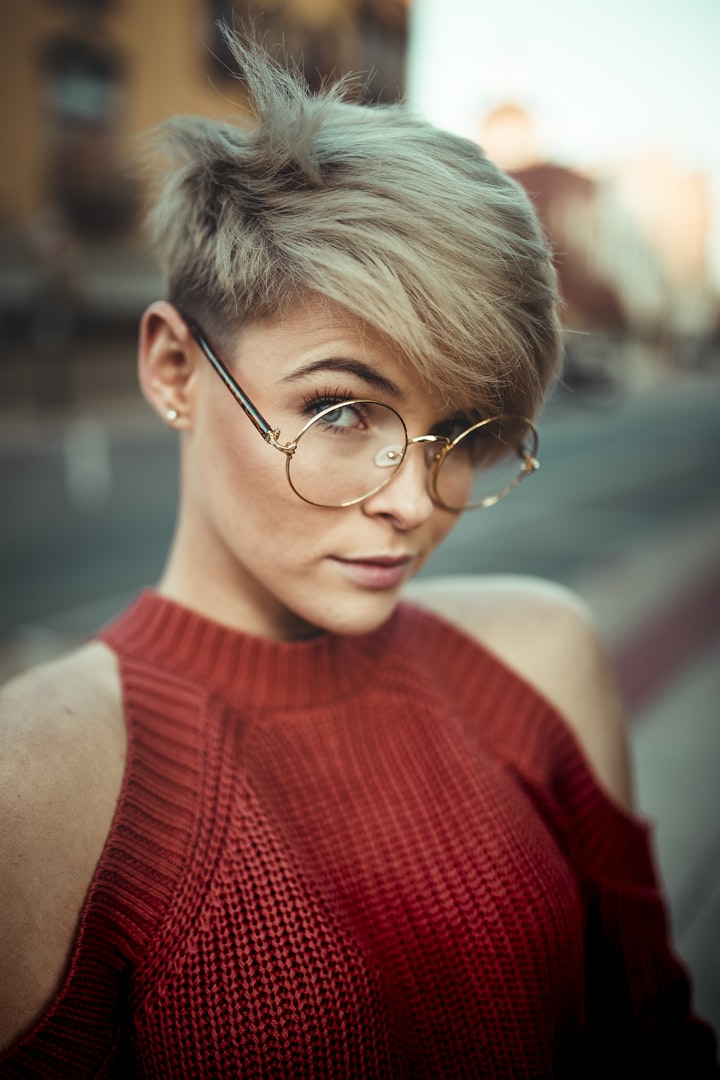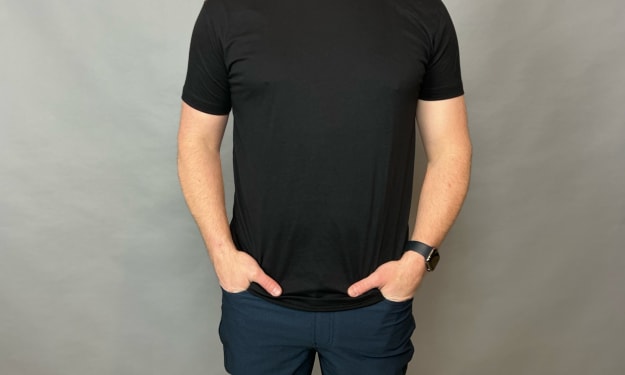I've Just Been Shot And That Bullet Has Sent Me Back To 1981
How Ashes to Ashes made me realise that I was born in the wrong decade

It’s an unexplainable wonder. A passion or a love that you don’t understand and can’t fully explain. I didn’t realise how much I loved the fashion of the 80s until I watched the hit TV series sequel to Life on Mars – Ashes to Ashes. Maybe I was an 80s fashionista in my previous life, or maybe I really was just born in the wrong decade, but there is something about the fashion of this underappreciated decade that I feel we could learn from and bring back to our own time. This isn’t just a matter of personal preference, but something I believe could be economically, environmentally and socially beneficial.
It's funny to perceive that a decade of such radical fashion choices could be something so multidimensional and beneficial for a modern day apparel, but there is a lot to be said for a mix of being stylish with baggy outfits, stylish with bright colours and stylish with smart casual; all rolled into one decade.
I will confess a bias, that when I refer to the fashion of the 80s I do primarily focus on the female’s apparel, mainly because that is what struck me in the series and struck me about the 80s and being female myself my love for the fashion put me into their shoes. This of course is not to say that this is not applicable for men’s wear too.
A snippet of common 1980s Fashion that I love

When I choose what to wear I often like to go somewhere between comfort and style, which can be a real struggle as the ‘fashionable’ look of the 2020s isn’t what I would classify as comfy, and to some respects not exceptionally fashionable either. It feels, to me, like a matter of ‘how much can I reveal without it being too much’ and unfortunately for the current cool-youth females it means tank tops and shorts that poke a little more than a teaser from behind. Admittedly, the 80s had its fair share of cropped tops and cropped jackets, but it was never unpleasantly revealing and it was worn with comfort and style. Casual wear incorporated baggy trousers and baggy tops brightened with the diversity of colour and layered with cheap big beads and sequins, wrapped together with a high impact belt and, not personally the most fathomable fashion concept, shoulder pads.
There was an explosion of fashion exploration in the 80s, some a success, others not so much. Denim is one concept of the 80s that I feel was understated and underappreciated. The denim fashion allowed for people to elaborate all means of colours and patterns that they could apply to their denim bottoms and denim jacket. Denim was a plain canvas that allowed people to explore any style they wished to, a personal adaptation without judgement.

Now there are undeniably tons more about the 80s fashion that could be discussed, but I’m going to wheel you off into an unconventional line of 80s fashion that arose within the TV series Ashes to Ashes that makes me really hope that the 80s fashion can be reborn.
How Ashes to Ashes made me realise I was born in the wrong decade
Ashes to Ashes explored the iconic styles of the 80s, from the architecture to The Gene Genie’s Quatro and, much deeper, a lot of racism and sexism that was acceptable within that time despite it being a decade of change. But here is where I find the interpretation of the fashion unique and a part I would love brought back as a common and popular trend– the smart casual.

The 1980s saw women in the workforce as a common fact of life. As a statement of equality within the workplace women started to dress more seriously at work, including knee length skirts, matching blazer and a blouse of different colour with kitten-heels as a common footwear. This aspect of the 1980s prevails in the series as the protagonist, Alex Drake, works as a DCI alongside her three male companions and Shaz, a police officer. But Alex Drake having been transported back in time to 1981 from 2008 brings with her the attitude of someone from the 21st century into the 80s. Her fashion is, to me, a statement of subtle chic, mixing elements of casual with smart - even in her ‘home-attire’ and not just at work.

I’ll be basic here. I am besotted over how Keeley Hawes rocks the white. In place of the denim she uses her white jacket and white boots as a canvas for her stylish bright tops, often slipped loosely off one shoulder. Then, when she’s not in her white cropped coat she is combining the smart slick blazer with her casual under-layer. I struggle to find something to dislike about this sassy stylish look that is so incorporable to personal adaptations and tastes. It’s a fitting flair not only as a comprehensive outfit but a mixture of style and comfort. Even though she doesn’t represent the common baggy bottoms of the 80s, her slick flexible yet tight trousers worn alongside the colourful baggy tops is reflective of the start of the 80s fashion advancement, which also encompassed tight Lycra or Leather miniskirts – something you can see with Shaz’s attire.

It’s clear that the series didn’t use a creative licence to adapt some bad-ass look into the 80s, as you can see a youthful popular 80s trend within Shaz’s attire. She is mostly seen in the series wearing her police outfit, but in her casual wear she is an exploration of the decade’s encompassing fashion statements. Smashing bright colours with her own canvas of black and also taking on a very unique element of the 80s that I also feel was overlooked – the beret. A subtle elegance on top the baggy bottoms and cheap plastic heavy beads, not a very common combination of fashion items, but somehow they just work. Don't believe me? See how Shaz owns the look.
-
This isn’t a heavy analysis into cultural and social contributing factors to the fashion, nor an in-depth analogy of the fashionistas, because to me the admirable qualities of the 80s fashion is much simpler. Undeniably, Ashes to Ashes proved to me that I was born in the wrong decade of fashion, and it’s hard to put into words why that is, but in a very simply explanation the fashion was multifaceted individually and globally within that decade. Ashes to Ashes explored a very unique underlying, adaptable and personally catchy style of that decade that I am absolutely besotted over and feel could and should be encompassed into our current fashion trends.
The Economic, Environmental and Social Benefits of adapting 1980s fashion into the 21st century
Ashes to Ashes not only made me realise how much I love the fashion, but also how much we can learn and benefit from it within our own day and age.

The Queer Community
The multifaceted fashions of the 80s showed a huge advancement in the social culture of that time both within the female empowerment and the further loosening of the stiff ‘Victorian’ stigma and general cliché stereotyping of the genders. The colours too in clothing became much brighter and more elaborate, bringing to it a sense of liberation from the bleak neutral tones and shades of previous decades.
The 80s fashion I felt encompassed a lot of non-conforming gender-specific styles, which in retrospect has over time stereotypically been associated within the queer communities – an obvious example being that of David Bowie.

But in the 80s, the crazy bright coloured and ‘thin-line’ between gender-associated outfits were worn with pride no matter your gender or sexuality. In the 21st century it is undeniably harder for one person to pop into their biologically-opposite gender’s department and find an item of clothing that fits their biological appearance. In short, female clothes are hyper-shaped to emphasise the hips and other bits, guys clothes can look like a sack for someone who isn’t flat chested. I don’t hypothesise this, I say it from experience, from trying a pair of lad’s cargo trousers (they never have baggy cargo trousers in the girl’s department) and a male designed Star Wars top. Now admittedly the 80s weren’t an openly accepting queer community but the fashion statement allowed every human to live under the same sky without being penalised by the prying eyes of prejudice peers. It also allowed for people to be open with how their sexuality/gender made them want to dress and still feel a part of the community. This is not implying that I think we should bring back the fashion in order to hide the queer community amongst the heteronormative society and conformity, but rather to bring integration into the fashion so it’s not segregated to just one group of people. Something that the 80s fashion, I believe did right.
Cheap Clothes and Fashion Accessories
My biggest statement of them all when it comes to how this decade’s fashion is beneficial socially, economically and environmentally comes from one simple concept – cheap clothes and fashion accessories. The cheap look was acceptable and enhanced in the 80s. Nowadays, however, if you want to be fashionable or wear clothes that look good, feel good and last long you have to pay the pied piper for it from high-end retail brands. You can buy cheap at stores like Primark, but not only are the materials made in a way that they don’t last long - meaning you inevitably spend the same amount of money as if you were buying from a pricy shop from all the many replacements - the materials also very quickly wear down and start to look and feel tatty. So how is this 80s cheap fashion beneficial and different?

Socially acceptable
Not everyone can afford the type of fashion that people strut the streets in. Some people are happy to bust their money on high-end fashion that will last them ages and will look great, but I for one, don’t, and sometimes can’t, afford to spend lots of money on these branded retailers and as such I don’t often feel comfortable in my clothes socially comparably. Making cheap the in-fashion brings with it an affordable platform for people from poorer backgrounds to feel a part of the community and not left out or, as they might feel, differentiated.
Economically beneficial
Recently my friend’s dissertation’s content and topic for her Economic studies struck me. She looked into the current fast-fashion, the fashion that constantly and rapidly changes to keep up with the constantly and rapidly changing times. The fast-fashion, unsurprisingly, creates a lot of wastage as a cause of left-over apparel that didn’t make it off the shelves in time for the newest fashion trends to take over. Unfortunately, many of these shops including New Look, Primark, Top Shop and several other high-end names have affordably been able to dump these ‘out-of-trend’ items into waste instead of recycling them back into the community. There are charitable organisations out there currently trying to work on this toxic, costly cycle, but this concept stuck with me for a long time and has made me reluctant to shop at these brands. In addition if you return an item of clothing to some of these shops, the item in particular isn’t often returned back to the shelf but instead, to be brusque, tossed down the garbage shoot. I am not fabricating this, it is a genuine concern that runs with the fast-fashion and is also a reason I have recently taken to charity shops and other second-hand markets.
Now with this long-winded explanation of fast-fashion’s fast-moving problems I heighten the idea of the 80’s cheap fashion trend’s perks and benefits. Rather than suggesting this trend returns so that the wasted garments are a cheaper disposal, it’s an ideal that the trend can, for both the retailers and the society, become an affordable system to recycle unwanted goods back into the community.
Environmentally friendly
Possibly the most juxtaposing proposition considering most of the cheap accessories were made from plastic in the 80s. Here’s my twist. If cheap fashion was reformed into our society it could build an entire platform for recycled goods to be fashionable. Again simply, plastic beaded necklaces can be made from recycled plastic or plastic that has been scoped out of the ocean. The type of materials and fabrics that would be recycled onto our backs would have an element of the 80s cheap fashion look, like the beads or even elaborately coloured and patterned clothing. The whole system could become hugely environmentally beneficial as there would be a large reduction in waste and all the money spent on these purchased items would go back into the companies that are working to keep the planet alive. Whilst there are charities out there who build on this idea, making jewellery out of recycled plastic, because this isn’t a current fashion trend it doesn’t bring in a lot of money which means that these accessories have to be sold at an unaffordable price. If the cheap fashion became a current trend there would be a market for these type of goods that could be sold within the cheap fashion market at affordable prices and in turn this sociably and economic benefit would also profit the planet.

I was a bit culturally naïve when it came to the fashion of previous eras, but Ashes to Ashes awoke me to a decade of fashion that enlightened me, not only in my personal love for the stylish fashion but how the trends could also be massively beneficial for the 21st century in the fight against economical wastage in the fast-fashion and the fight against our growing environmental disasters.
About the Creator
Megan Kingsbury
Author 📝Actress 🎭 and Film Director 📽️ by day
Animation 🎬 fanatic by night
Cosplayer 🖌️🪡 all the way in between






Comments
There are no comments for this story
Be the first to respond and start the conversation.